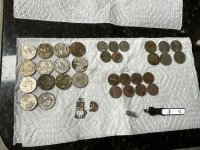I am rather new to the hobby. I have gone round in round in circles trying to choose a detector. At one time I was chasing a Garrett 2500, but have decided that it is overpriced and not in the same category as those listed above.
I am trying to decide between used units; either a Minelab Explorer II or S, a Whites DFX or a Whites XLT. I will be using it primarily in South Texas to do coin, jewelry or relic hunting. I might take it to the beach occasionally, but that is not my primary focus. I doubt I will ever go prospecting. I would prefer a digital display.
Based on reading a ton, I have reached the conclusion that the Minelab Explorer is superior machine, but extremely difficult to learn. It looks like I can get a used Explorer actually cheaper than a used DFX or XLT. I am relatively computer/technology literate, but I am not a gadget geek or engineering type.
My questions are:
1. Should be afraid of the learning curve for the explorer?
2. Do you agree that this is a better machine than the White's?
3. Any suggestion regarding if you would recommend one of these machines over the other?
Thanks a lot.
Byron.
I am trying to decide between used units; either a Minelab Explorer II or S, a Whites DFX or a Whites XLT. I will be using it primarily in South Texas to do coin, jewelry or relic hunting. I might take it to the beach occasionally, but that is not my primary focus. I doubt I will ever go prospecting. I would prefer a digital display.
Based on reading a ton, I have reached the conclusion that the Minelab Explorer is superior machine, but extremely difficult to learn. It looks like I can get a used Explorer actually cheaper than a used DFX or XLT. I am relatively computer/technology literate, but I am not a gadget geek or engineering type.
My questions are:
1. Should be afraid of the learning curve for the explorer?
2. Do you agree that this is a better machine than the White's?
3. Any suggestion regarding if you would recommend one of these machines over the other?
Thanks a lot.
Byron.
Amazon Forum Fav 👍
Upvote
0



 They are a great company. I love my DFX, however, I DO see a difference in depth...SE is deeper (with stock coils on each), at least in my experience. Now, if I put my 18" Excelerator on my DFX, well...you get the picture. I just use whichever one is best for a particular environment. I agree that you simply can't go wrong with a DFX, but I use my SE on the beach and when hunting deep coins, or when hunting under power lines. Just my humble opinion.
They are a great company. I love my DFX, however, I DO see a difference in depth...SE is deeper (with stock coils on each), at least in my experience. Now, if I put my 18" Excelerator on my DFX, well...you get the picture. I just use whichever one is best for a particular environment. I agree that you simply can't go wrong with a DFX, but I use my SE on the beach and when hunting deep coins, or when hunting under power lines. Just my humble opinion.


